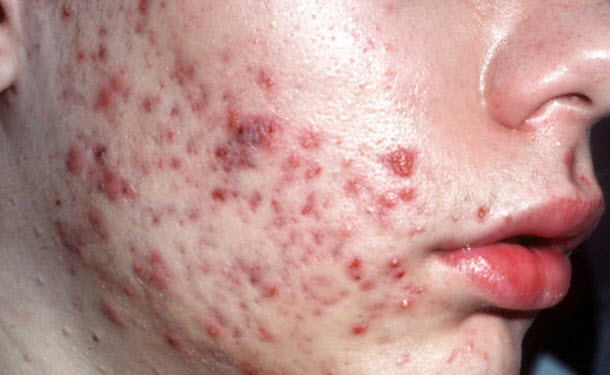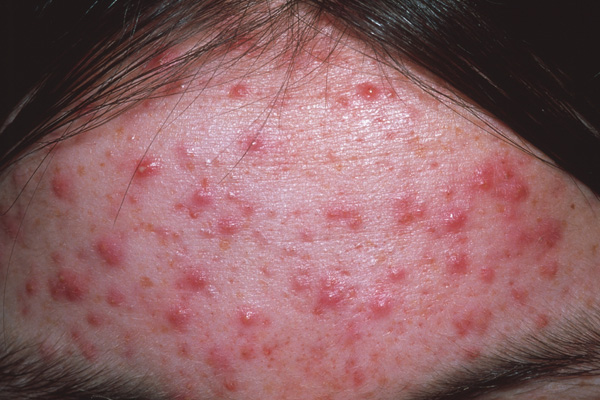Related Subjects:
|Nikolsky's sign
|Koebner phenomenon
|Erythema Multiforme
|Pyoderma gangrenosum
|Erythema Nodosum
|Dermatitis Herpetiformis
|Lichen Planus
|Acanthosis Nigricans
|Acne Rosacea
|Acne Vulgaris
|Alopecia
|Vitiligo
|Urticaria
|Basal Cell Carcinoma
|Malignant Melanoma
|Squamous Cell Carcinoma
|Mycosis Fungoides (Sezary Syndrome)
|Xeroderma pigmentosum
|Bullous Pemphigoid
|Pemphigus Vulgaris
|Seborrheic Dermatitis
|Pityriasis/Tinea versicolor infections
|Pityriasis rosea
|Scabies
|Dermatomyositis
|Toxic Epidermal Necrolysis
|Stevens-Johnson Syndrome
|Atopic Eczema/Atopic Dermatitis
|Psoriasis
Commonly begins during early puberty with increased activity
throughout the teens with spontaneous resolution thereafter
About
- Inflammation of the pilosebaceous unit of the skin
- Affecting mainly adolescents and may cause scarring
Aetiology
- Multifactorial but possibly a genetic component
- Males > Females in adolescence but reverse in adulthood
- Hormonal, inflammation, skin lipid composition and sebum production
- Overgrowth of Propionibacterium acnes
- Hyperproliferation of epithelial cells with obstructed ducts
- Pathology shows distension of pilosebaceous unit with neutrophils
Old myths
- It is caused by dirt or poor personal hygiene
- It is due to a poor diet
Causes/Exacerbating factors
- Congenital adrenal hyperplasia, Polycystic ovary syndrome
- Cushing's syndrome, high androgen levels
- Drugs - steroids, lithium, some antiepileptics
- Any cause of androgen excess
Clinical
- Primary lesion = microcomedo (clinically unrecognizable = microscopic
plugging of pilosebaceous unit)
- Open Comedones - "white heads" without surrounding inflammation
- Closed Comedones - "black heads" - due to oxidation of melanin pigment
- Papules, pustules and nodules and even cysts
- Can extend to torso, neck, chest and shoulders
- Can worsen with menstruation


Severity
- Mild: open and closed comedone with or without sparse inflammatory lesions
- Moderate acne: multiple widespread non-inflammatory lesions with many papules and pustules
- Severe acne: extensive inflammatory lesions, which may include nodules, pitting, and scarring
Investigations
- Very rarely needed except with unusual or very severe presentation
- FSH, LH, Prolactin, Sex hormone-binding globulin, Testosterone levels, 17(OH) progesterone
- Abdominal CT if adrenal tumour suspected
Differential
- Folliculitis, Acne rosacea, Adenoma sebaceum
Management: see NICE Acne vulgaris: management (NG198)
- Skin Care: Use a non-alkaline (skin pH neutral or slightly acidic) synthetic detergent (syndet) cleansing product twice daily on acne-prone skin. Avoid oil-based and comedogenic preparations. If used then advise people with acne who use make-up to avoid oil-based and comedogenic products to remove make-up at the end of the day. Advise people that persistent picking or scratching of acne lesions can increase the risk of scarring.
- Diet: Advise people that there is not enough evidence to support specific diets for
treating acne. Advise a balanced healthy diet.
- Acne fulminans: Urgently refer people with acne fulminans on the same day to the on-call hospital
dermatology team, to be assessed within 24 hours.
Refer to specialists
- Diagnostic uncertainty about their acne, they have acne conglobata or they have nodulo-cystic acne.
- Mild to moderate acne that has not responded to 2 completed courses of treatment
- Moderate to severe acne which has not responded to previous treatment that contains an oral antibiotic
- Acne that is leading to scarring or persistent pigmentary changes.
- Acne with persistent psychological distress or a mental health disorder.
- Refer Urgently to mental health if suicidal ideation or self-harm a severe depressive or anxiety disorder
body dysmorphic disorder.
First Line
- Offer people with acne a 12-week course of 1 of the following first-line treatment
options, taking account of the severity of their acne and the person's
preferences, and after a discussion of the advantages and disadvantages of each
option
- Acne Any severity: Topical adapalene with topical benzoyl peroxide. Applied once daily in the evening. Does not contain antibiotics. Not for use during pregnancy. Use with caution during breastfeeding. Can cause skin irritation
- Acne Any severity: Topical tretinoin with topical clindamycin applied once daily in the evening topical. Not for use during pregnancy or breastfeeding. Can cause skin irritation, and photosensitivity.
- Acne Mild to Moderate: Topical benzoyl peroxide with topical clindamycin once daily in the evening Topical. Can be used with caution during pregnancy and breastfeeding. Can cause skin irritation, photosensitivity, and bleaching of hair and fabrics
- Acne Mod to severe: Fixed combination of topical Adapalene with topical Benzoyl peroxide, together with either oral lymecycline or oral doxycycline for moderate to severe acne. Taken once daily. Oral component may be effective in treating affected areas that are difficult to reach with topical treatment. Not for use in
pregnancy, during breastfeeding or under the age of 12. Adapalene and topical benzoyl peroxide can cause
skin irritation, photosensitivity, and bleaching of hair and fabrics. Oral antibiotics may cause systemic side effects and antimicrobial resistance. Oral tetracyclines can cause photosensitivity
- Acne Moderate to severe: Topical azelaic acid applied twice daily, plus either oral lymecycline or oral doxycycline taken once daily. May be effective in treating affected areas that are difficult to reach with topical treatment (such as the back). Not for use in pregnancy, during breastfeeding or under the age of 12. Oral antibiotics may cause systemic side effects and resistance. Oral tetracyclines can cause photosensitivity
Topical retinoids and oral tetracyclines are contraindicated during
pregnancy and when planning a pregnancy
Review at 3 months
- Review first-line treatment. Assess whether the person's acne has improved, and whether they have any side effects in people whose treatment includes an oral antibiotic, if their acne has completely cleared consider stopping the antibiotic but continuing the topical treatment
- In people whose treatment includes an oral antibiotic, if their acne has improved but not completely cleared, consider continuing the oral antibiotic, alongside the topical treatment, for up to 12 more weeks.
- Consider oral isotretinoin for people older than 12 years who have a severe form of acne that is resistant to adequate courses of standard therapy with systemic antibiotics and topical therapy. For example: nodulo-cystic acne, acne conglobata, acne fulminans, acne at risk of permanent scarring.
- The initiation of isotretinoin treatment in people under 18 requires agreement by 2 independent healthcare professionals that there is no other appropriate effective treatment before it is prescribed
- When considering oral isotretinoin for acne take into account the person's psychological wellbeing and refer them to mental health services before starting treatment if appropriate
- If a person for whom oral isotretinoin treatment is being considered has the
potential to become pregnant: explain that isotretinoin can cause serious harm to a developing baby if taken
during pregnancy and inform them that they will need to follow the MHRA pregnancy prevention
programme as detailed on the isotretinoin acknowledgement of risk form.
- Prescribe oral isotretinoin for acne treatment at a standard daily dose of 0.5 to 1 mg/kg or Consider a reduced daily dose of isotretinoin (less than 0.5 mg/kg) for people at increased risk of, or experiencing, adverse effects.
- When giving isotretinoin as a course of treatment for acne: continue until a total cumulative dose of 120 to 150 mg/kg is reached, but if there has been an adequate response and no new acne lesions for 4 to 8 weeks, consider discontinuing treatment sooner.
Steroids
- If an acne flare (acute significant worsening of acne) occurs after starting oral
isotretinoin, consider adding a course of oral prednisolone.
- When a person with acne fulminans is started on oral isotretinoin, consider
adding a course of oral prednisolone to prevent an acne flare
- Consider treating severe inflammatory cysts with intralesional injection of
triamcinolone acetonide
Images online

